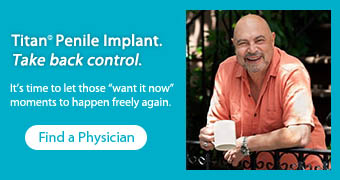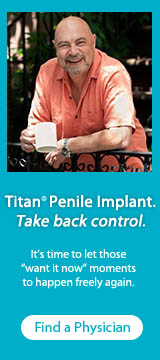Craigdwill wrote:The implant is AMS 700. I don’t know size, etc. my surgery was three weeks ago, but my first follow up was delayed until Jan. 10. I was sent home with post-op instructions to start cycling when I was no longer swollen, bruised or sore. Today was first time I tried pumping.
I have an AMS LGX and I beleive the pump is the same as-particularly yours, so my experience should be relevant.
When I first began to pump my implant, the valve was in in the "deflate" mode. (That is, AFTER deflating and NOT re-setting the valve, as many men -particularly with the Coloplast valves). A firm (not necessarily quick, but definitely firm and swift) squeeze would produce a palpable "crush" of the pump bulb. The bulb would be very firm and at some point, collapse becoming less firm when the valve rocks over to inflte mode.
Another way of looking at it is that when the valve is in deflate mode, the pump bulb is firm because the valve resists compression. Very little resistance to compression from hydrostatic pressure in the implant tubes, though. Just resistannce of the valve. When the valve flips to inflate mode, the resistance of the valve is suddenly gone. And the resistance of hydrostatic pressure in the implant's tubes is minimal, since the tubes are slack. As one pumps ore pressure into the implant tubes, that hydrostatic pressure increases.
All the foregoingdoes not take into account firmness of the pump bulb itself. Think of a tennis ball with two holes in it. Even if fluid flow through the holse was unrestricted, the tennis ball would resist being crushed easily. This is necessarhy because the tennnis ball is required to refill itself. Over time the tennis ball (pump bulb) gets "broken in" this resistance to pumping decreases.
Conintuing the tennis ball analogy, Valving allows fluid to go in or out whichever hole depending on the position of the valve. When the valve is set one way, squezing the ball sends fluid forcefully into th e implant tubes and he fluid is prevented from returning to the reservoir. When the valve is the other way, fluid can flow freely (by hydrostatic pressure from the implant tubes back into the reservoir.
To flip the valve from inflate mode to deflate mode, one must press a button on the valve body. To flip the valve from deflate mode to inflate mode, there is no button you can press. Instead, a firm squeeze on the tennis ball (pump bulb) presses an internal (button or something like it) device to put the valve into inflte mode. Pressing that internal button requires a firm squeeze. After that only the hydrostatic pressure in the implant tubes provide resistance to squeezing the bulb/ball.
Sorry to be so long-winded, but it is late and I am tired. If I had more time I would have written a shorter post.






